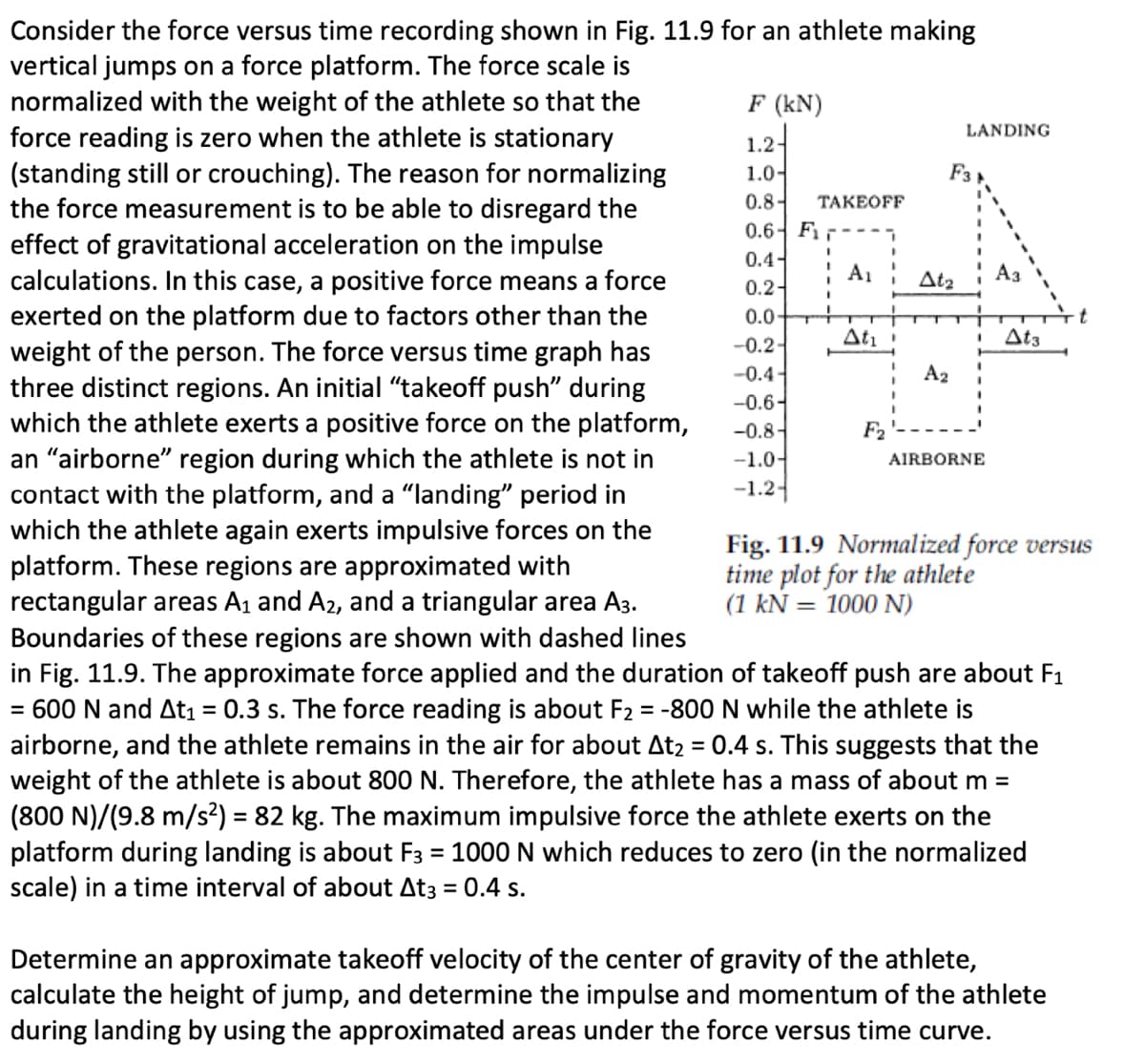F (kN) LANDING Consider the force versus time recording shown in Fig. 11.9 for an athlete making vertical jumps on a force platform. The force scale is normalized with the weight of the athlete so that the force reading is zero when the athlete is stationary (standing still or crouching). The reason for normalizing the force measurement is to be able to disregard the effect of gravitational acceleration on the impulse calculations. In this case, a positive force means a force exerted on the platform due to factors other than the weight of the person. The force versus time graph has three distinct regions. An initial "takeoff nush” during. 1.2- 1.0- 0.8- TAKEOFF 0.6 F A1 At2 ' At₁ Ats A2 0.4- 0.2- 0.0 -0.2- -0.4-
F (kN) LANDING Consider the force versus time recording shown in Fig. 11.9 for an athlete making vertical jumps on a force platform. The force scale is normalized with the weight of the athlete so that the force reading is zero when the athlete is stationary (standing still or crouching). The reason for normalizing the force measurement is to be able to disregard the effect of gravitational acceleration on the impulse calculations. In this case, a positive force means a force exerted on the platform due to factors other than the weight of the person. The force versus time graph has three distinct regions. An initial "takeoff nush” during. 1.2- 1.0- 0.8- TAKEOFF 0.6 F A1 At2 ' At₁ Ats A2 0.4- 0.2- 0.0 -0.2- -0.4-
Related questions
Question

Transcribed Image Text:F (kN)
1.2-
1.0-
0.8-
0.6 F
0.4-
0.2-
TAKEOFF
LANDING
A₁
A3
At2
0.0
-0.2-
Atı!
Atз
-0.4-
A2
-0.6-
-0.8-
F2
AIRBORNE
-1.0-
Consider the force versus time recording shown in Fig. 11.9 for an athlete making
vertical jumps on a force platform. The force scale is
normalized with the weight of the athlete so that the
force reading is zero when the athlete is stationary
(standing still or crouching). The reason for normalizing
the force measurement is to be able to disregard the
effect of gravitational acceleration on the impulse
calculations. In this case, a positive force means a force
exerted on the platform due to factors other than the
weight of the person. The force versus time graph has
three distinct regions. An initial “takeoff push" during
which the athlete exerts a positive force on the platform,
an "airborne" region during which the athlete is not in
contact with the platform, and a "landing” period in
which the athlete again exerts impulsive forces on the
platform. These regions are approximated with
rectangular areas A1 and A2, and a triangular area A3.
Boundaries of these regions are shown with dashed lines
in Fig. 11.9. The approximate force applied and the duration of takeoff push are about F1
= 600 N and At₁ = 0.3 s. The force reading is about F2 = -800 N while the athlete is
airborne, and the athlete remains in the air for about At2 = 0.4 s. This suggests that the
weight of the athlete is about 800 N. Therefore, the athlete has a mass of about m =
(800 N)/(9.8 m/s²) = 82 kg. The maximum impulsive force the athlete exerts on the
platform during landing is about F3 = 1000 N which reduces to zero (in the normalized
scale) in a time interval of about At3 = 0.4 s.
-1.2
Fig. 11.9 Normalized force versus
time plot for the athlete
(1 kN = 1000 N)
Determine an approximate takeoff velocity of the center of gravity of the athlete,
calculate the height of jump, and determine the impulse and momentum of the athlete
during landing by using the approximated areas under the force versus time curve.
Expert Solution
This question has been solved!
Explore an expertly crafted, step-by-step solution for a thorough understanding of key concepts.
Step by step
Solved in 4 steps with 10 images
